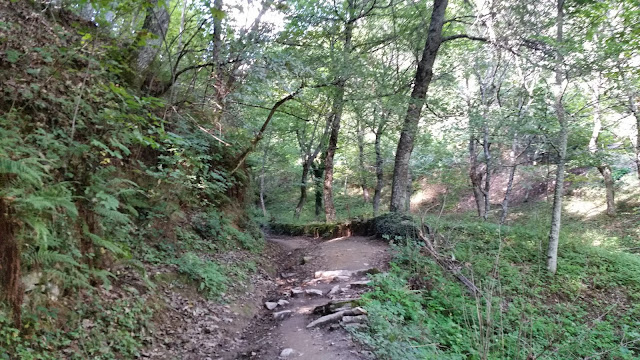Today, we drove out to Finisterre and Muxia. As I mentioned in yesterday's blog, these 2 places are now being considered more and more a continuation of the Camino, after visiting Santiago. Both are on the coast. Finisterre was visited often back in the Middle Ages because it was considered to be "the end of the world" (finis is "end", and terre is "earth", so it's name literally means "end of the earth"). It was thought to be the point farthest west on all of continental Europe, and since people thought the world was flat back then, the point farthest to the west was considered the end (looking at a map now, it appears there are parts of Portugal that are actually further west, but hey, this was back in the Middle Ages so we should cut them some slack).
There is a nice lighthouse out on the point of Finisterre, and there were also really nice beaches in the town of Langosteria, which is right before Finisterre. There is a tradition for some of the pilgrims who go to Finisterre to leave something there. Typically it was shoes, or socks, or something else that got worn out along the way. Álso, we saw a lot of fire pits in amongst the rocks, so we were guessing that people came out to watch the sunset and built a small fire to stay warm. And there were also some stacks of stones called cairns, which people built as a good luck "charm". We saw a lot of these cairns along the Camino. And lastly, there were a couple of crosses that people had made from sticks and then stuck them in the ground. The first picture is looking across the way to Finisterre to the left and Langosteria to the right (with the nice long, curved beach). The second picture is of us at the outcropping that extends beyond the lighthouse at Finisterre, looking up the coastline.
While Muxia was also right on the coast, it definitely had a different feel to it. It was down closer to the water, and the rocks were much bigger and went out more gradually into the water, so you could go out and climb around on them. You could also see that the water came in pretty far at high tide. But what probably created the most difference was the church that was built out on the point in Muxia, which is the final picture (you can also see the Muxia lighthouse just to the left of the church). Unfortunately, the church was hit by lightening back in November, which caused a fire. Hence, all the scaffolding around the building for restoration work. Anyway, the rounded rocks and the church made for a more serene feel to the whole place. And there were a lot fewer people, too, which made it quieter as well.
All in all, Linda and I both agreed that if we had had more time, we would have really enjoyed hiking out to both Finisterre and Muxia and spending an extra day out there (the beaches would make for some good R&R as well). People told us it takes 3 days to hike from Santiago to Finisterre, and 1 day to go from Finisterre to Muxia. So for any of you who are considering doing the Camino, I would highly recommend adding this on to your trip if you can.



















































